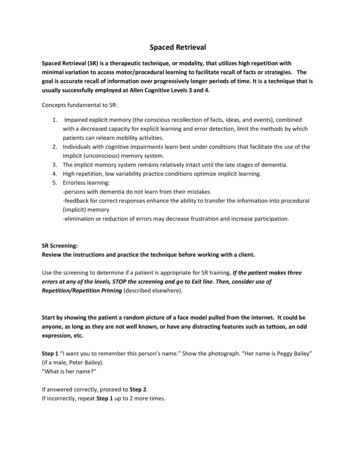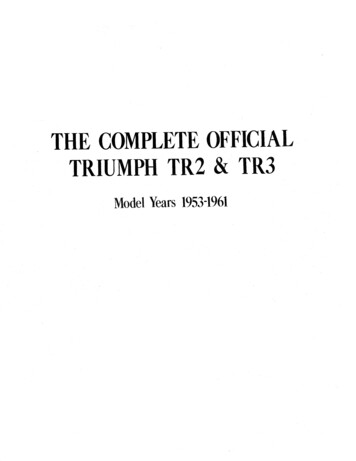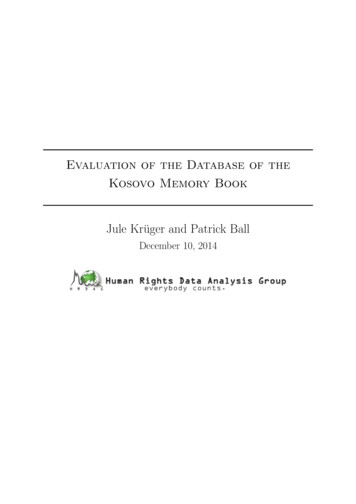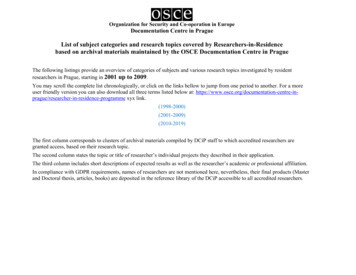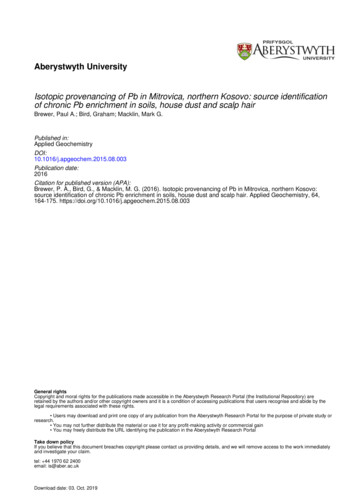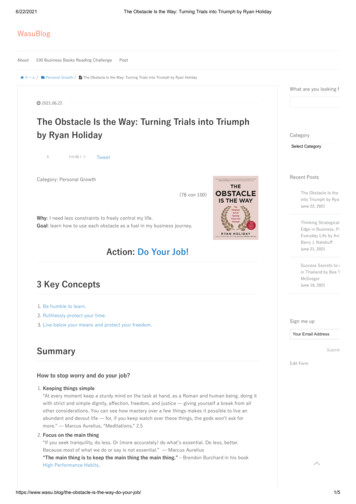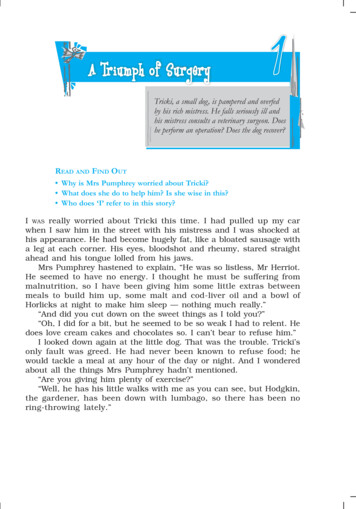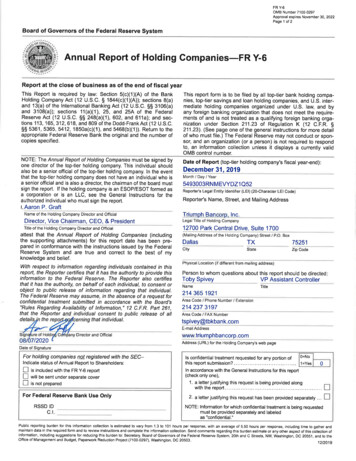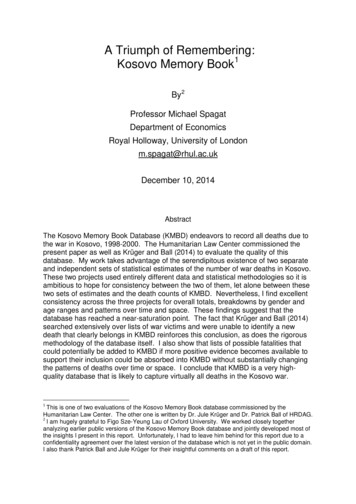
Transcription
A Triumph of Remembering:Kosovo Memory Book1By2Professor Michael SpagatDepartment of EconomicsRoyal Holloway, University of Londonm.spagat@rhul.ac.ukDecember 10, 2014AbstractThe Kosovo Memory Book Database (KMBD) endeavors to record all deaths due tothe war in Kosovo, 1998-2000. The Humanitarian Law Center commissioned thepresent paper as well as Krüger and Ball (2014) to evaluate the quality of thisdatabase. My work takes advantage of the serendipitous existence of two separateand independent sets of statistical estimates of the number of war deaths in Kosovo.These two projects used entirely different data and statistical methodologies so it isambitious to hope for consistency between the two of them, let alone between thesetwo sets of estimates and the death counts of KMBD. Nevertheless, I find excellentconsistency across the three projects for overall totals, breakdowns by gender andage ranges and patterns over time and space. These findings suggest that thedatabase has reached a near-saturation point. The fact that Krüger and Ball (2014)searched extensively over lists of war victims and were unable to identify a newdeath that clearly belongs in KMBD reinforces this conclusion, as does the rigorousmethodology of the database itself. I also show that lists of possible fatalities thatcould potentially be added to KMBD if more positive evidence becomes available tosupport their inclusion could be absorbed into KMBD without substantially changingthe patterns of deaths over time or space. I conclude that KMBD is a very highquality database that is likely to capture virtually all deaths in the Kosovo war.1This is one of two evaluations of the Kosovo Memory Book database commissioned by theHumanitarian Law Center. The other one is written by Dr. Jule Krüger and Dr. Patrick Ball of HRDAG.2I am hugely grateful to Figo Sze-Yeung Lau of Oxford University. We worked closely togetheranalyzing earlier public versions of the Kosovo Memory Book database and jointly developed most ofthe insights I present in this report. Unfortunately, I had to leave him behind for this report due to aconfidentiality agreement over the latest version of the database which is not yet in the public domain.I also thank Patrick Ball and Jule Krüger for their insightful comments on a draft of this report.
1. IntroductionThe charter for the recognition of every casualty of armed violence, launched onSeptember 15, 2011 (Every Casualty, 2011a), calls upon states and other relevantarmed conflict actors to ensure that all conflict casualties are promptly recorded,correctly identified and publicly acknowledged. Appropriately, the Humanitarian LawCenter (HLC) and the Humanitarian Law Center – Kosovo (HLCK) played a centralrole in the launch (Every Casualty, 2011b). Indeed, HLC and HLCK began work ontheir Kosovo Memory Book project long before the Every Casualty project wasconceived and it is hard to think of any project in the world that is more in tune withthe Every Casualty goals than is the Kosovo Memory Book (Humanitarian LawCenter and Humanitarian Law Center-Kosovo, 2014a).The core goals of both Every Casualty and Kosovo Memory Book are torecord, memorialize, remember and acknowledge every single conflict death –individual by individual. These groups view conflict recording as an essential humanactivity, akin to burial rituals.In this report I study statistical estimates and counts of fatalities in the Kosovowar. This analysis may seem far removed from the core purpose of Kosovo MemoryBook which is to remember the human victims of the war one by one. Yet I suggestthat the material presented in this paper does, indeed, serve a core purpose of theKosovo Memory Book because it supports the case that HLC and HLCK have builtan accurate and virtually comprehensive record of fatalities due to the Kosovowar. 34 This is important because HLC and HLCK can only achieve their core goalsif they accurately list virtually every single victim of the war. Thus, the present reportprovides good evidence that Kosovo Memory Book is an exemplary success withinthe framework established by the Every Casualty project.The structure of this report is as follows. In sections 2 and 3 I compare theviolent death counts of the Kosovo Memory Book database with those of two3There will always be the possibility that compelling evidence of a new death will surface so no oneshould every claim that any such database is fully comprehensive.4Krüger and Ball (2014) address the same questions from many different angles and come to thesimilar conclusions.1
different statistical estimates. I find strong consistency across the sources on thetotal number of deaths as well as on how these deaths are distributed across time,space and demographic categories. In section 4 I draw attention to the work ofKrüger and Ball (2014) searching many lists of Kosovo war victims, including somethat HLC and HLCK have not had access to. They do not find any deaths thatclearly belong in the Kosovo Memory Book database but that are not already there.The rigorous methodology of the database renders this finding understandable(Humanitarian Law Center and Humanitarian Law Center-Kosovo, 2014b). Sectionfive considers candidates currently held to the side for potential integration into thedatabase at a later stage if compelling evidence surfaces that they belong in there. Ishow that even transfer of a large proportion of these potential deaths into the maindatabase would have no discernable effect on the Kosovo Memory Book databaseas a whole. I draw some conclusions in section six.2. Kosovo Memory Book versus the Spiegel and Salama Estimatesa. Why this comparison is interesting and important to usThe main goal of Spiegel and Salama (2000, hereafter “S&S”) was to estimate thenumber of people killed in the Kosovo war. A secondary goal was to give relativelydetailed breakdowns on how estimated deaths were spread across time anddemographic groups. In particular, S&S gave monthly estimates and alsodisaggregated their totals into males and females belonging to three broad ageclasses - six demographic groups in total. This level of detail enables richcomparisons between S&S and the Kosovo Memory Book database (KMBD).S&S based their estimates on data gathered by a sample survey. 5 Thismeans they started by drawing a random sample of households in Kosovo. Theythen conducted a household interview to record, among other things, the number ofviolent deaths suffered by household members. The interview also recorded thepresence of other live and dead household members, accounting for births, nonviolent deaths, in-migration and out-migration.5Spagat (2012) gives an overview of the use of sample surveys for measuring deaths in armedconflict.2
The key step in this approach is to project the violent death rate found withinthe sampled households onto the entire population of Kosovo. The estimate ofviolent deaths arrived at by this technique will be correct on average under certainideal conditions that the survey strived to attain. This averaging is over all thepossible samples that could have been drawn via the procedures S&S used to drawthe one sample that they analyzed. There are, in fact, reasons to believe that moreoften than not survey estimates are below the true number they are trying toestimate even though they get the right answer on average (Spagat, 2009, slide 9). 6A survey departs from ideal conditions if, for example, the household interviewdoes not accurately elicit the correct information or the sampling proceduressystematically favor selecting households that have experienced more (or less)violence than is typical for the population as a whole. No survey, including S&S,satisfies all the ideal conditions but S&S does appear to be a fairly high-qualitysurvey so we would expect it to produce reasonable estimates.S&S follow the standard practice of using their sample to quantify how fartheir estimate may deviate from the true number of deaths, always operating underthe maintained assumption that the ideal conditions for a survey are satisfied. Thiscalculation aims to capture the characteristics of a plausible range of householdsamples that could have been randomly selected; each sample will lead to a differentestimate of the number of violent deaths. The resulting range, known as a “95 %confidence interval,” incorporates uncertainty due to the sample being random butdoes not normally account for possible departures from ideal conditions.The above discussion applies to sub-categories of deaths as well as to totaldeaths. However, we must be aware that the more specific the category of death themore uncertain the survey-based estimates will be. Estimates of violent deaths in amonth will be less reliable than estimates of violent deaths in a year. Estimates for6This asymmetry results from the fact that households without violent deaths greatly outnumberhouseholds with violent deaths. This means that most random sample will contain too manyhouseholds without violent deaths while a fair number of the samples that contain too many violentdeaths will actually contain far too many violent deaths.3
males will be less reliable than estimates for females plus males. Nevertheless,under ideal conditions these estimates should be correct on average.The S&S survey appears to be a high-quality one. Thus, the abovediscussion gives us a valid theoretical basis to believe that the overall S&S estimateis likely to be close to the true numbers of violent deaths in the Kosovo war.Estimates for more specific categories such as months, genders or age ranges aremore subject to random variation than the overall estimate is but can still beexpected to be reasonably close to correct values. Confidence intervals, whichquantify the uncertainty of working with a random sample rather than the entirepopulation of Kosovo, provide at least a partial handle on the uncertainty surroundingthese estimates.If the KMBD database is a virtually comprehensive list of deaths in the Kosovowar then the total number of violent deaths in the KMBD database should be similarto the S&S estimate for violent deaths. Moreover, KMBD totals by month, genderand age should also resemble the S&S estimates. We must remember that there isa large random component within the S&S estimates, especially in sub-categories,so we should not be surprised to see a few strong deviations between KMBD andS&S numbers. Still, they should be quite close to one another on average.b. The comparisonsWe eliminate the 281 “deaths caused by war” from KMBD to put it on a comparablebasis with the S&S estimates of “war-related trauma” which do not include nonviolent deaths that can be attributed to the war as KMBD does. We also limit KMBDto just the period January 1, 1998 through September 30, 1999 since this is theperiod covered by S&S. We are left with 12,965 violent deaths in KMBD that are fitfor comparison with S&S.The totals for the two projects for the whole S&S period are close – 12,965 forKMBD versus 12,010 with a 95% confidence interval of 5,500 to 18,300 for S&S. Asmentioned above, survey estimates under ideal conditions should come out belowthe true number more often than not so KMBD and S&S line up very much like one4
would expect if both projects are accomplishing their goals, specifically, recordingevery war death for KMBD and estimating the true number of war deaths for S&S.Table 1. KMBD Versus S&S – Violent Deaths by Age and GenderSpiegel and Salama EstimatesAge Range/GenderKosovo Memory BookLowerLimitCentral EstimateUpperLimitCountsMales0161 (44%)523353 (61%)Females0201 (56%)522222 (39%)0-14 YearsTotal362 (100%)575 (100%)15-49 YearsMales16945421 (91%)90137262 (92%)Females0510 (9%)8379645 (8%)Total5931 (100%)7907 (100%)50 YearsMales21645176 (91%)82093616 (81%)Females0541 (9%)1302867 (19%)5717 (100%)4483 (100%)All AgesMales385810758 (90%)1774411231 (87%)Females01252 (10%)102041734 (13%)Grand Total550012010 (100%)1830012965 (100%)Lower and upper limits refer to 95% confidence intervals. Calculations for S&S are based on theirtable 2, except for the confidence interval for the "Grand Total" which is their overall range.There is another reason why it is notable that the KMBD total is higher thanthe S&S central estimate of 12,010. One might expect the KMBD count to be lower5
than the true number of violent deaths since it is extremely difficult to detect everysingle death on a case-by-case basis. 7 Therefore, exceeding a valid statisticalestimate like the S&S one is a sign the KMBD may be virtually comprehensive.The S&S paper gives a breakdown by gender and age categories, enabling adirect comparison with KMBD along these dimensions as shown in table 1. Thesedetailed comparisons are consistent with the notion that KMBD is virtuallycomprehensive. KMBD counts exceed the S&S central estimates for all subcategories except males aged 50 and are always well below the upper limit of the95% confidence interval for S&S. It seems clear that 50 males weredisproportionately targeted during the war although the S&S estimate appears toexaggerate the extent to which this is true, most likely due to a random variationwithin the sample.Figure 1 compares monthly time series for the KMBD and S&S. 8 The twoseries track each other remarkably well, particularly considering that the S&S seriesis based on only 50 clusters of 24 households and is, therefore, subject to ratherstrong random variation once the estimates are disaggregated down to a monthlylevel. Unfortunately, we cannot quantify this randomness with confidence intervalsbecause the original S&S data have been lost. 97It is, however, possible for a documented count like KMBD’s to exceed the true number of deaths ifthere are duplicates or false deaths lying undetected within the database.8Figo Sze-Yeung Lau of Oxford University and I built the monthly numbers for the S&S time seriesvia painstaking inspection of figure 2 of the S&S paper.9Personal correspondence with Paul Spiegel.6
The correlation between the two monthly series is 0.86 on a scale from 0 to 1where 1 would indicate perfect tracking and 0 would indicate a complete absence oftracking. Even if KMBD is a perfect record of all violent deaths in the Kosovo warand S&S is an exceptionally high-quality survey we would still never expect thecorrelation to be 1.0 since the S&S estimate comes from a random sample. Basedon the available information 0.86 appears to be an excellent result.In summary, the KMBD-S&S comparisons come out quite well. They are atleast consistent with KMBD being a virtually complete and very high qualitydatabase.3. Kosovo Memory Book versus the Ball et al. Estimatesa. Why this comparison is interesting and important to us7
Ball, Betts, Scheuren, Dudukovic and Asher (2002) (hereafter BBSDA) madestatistical estimates of violent deaths in the Kosovo war that were entirelyindependent of S&S and used a completely different method known as “multiplesystems estimation (MSE).” 10It is interesting to compare the BBSDA estimates with KMBD numbers for thesame reason it is interesting to compare S&S with KMBD. Under ideal conditionsthe BBSDA method should give the true number of violent deaths on average so iftotal deaths recorded by KMBD are close to this true number then KMBD numbersshould also be close to BBSDA estimates subject to the caveat that the BBSDAestimates have random noise built into them.There are three main reasons why this second round of comparisons addsvaluable new information to our analysis. First, S&S is based on a random sampleso its sample could turn out to be rather unrepresentative of the population eventhough it was a well conducted survey. If the S&S estimate does suffer from such arandom aberration we would have a decent chance of catching this problem bylooking at a second estimate. Second, BBSDA use a different statistical techniquethan S&S do so if one of these projects is inaccurate due to strong departures fromideal conditions for the application of the technique (rather than just randomvariation) then there is a reasonable chance that this problem will be detected by theother project. Third, we can compare KMBD and BBSDA by regions, something thatwas not possible with S&S since this paper does not provide geographicalinformation.BBSDA’s statistical technique is, unfortunately, more complicated, less intuitiveand less familiar than are S&S’s survey methods. The survey approach works bycontrolling and understanding the random procedures by which data are gathered.Within the context of estimating war deaths MSE is normally invoked when datahave already been gathered by multiple organizations that have not followed thecontrolled randomization procedures that underpin sample surveys. Researchers10Manrique-Vallier, Price and Gohdes (2013) and Jewell, Spagat and Jewell (2013) provide overviewsof the application of MSE techniques to estimating deaths in armed conflict.8
then try to model the processes whereby deaths are captured, or not captured, bythese multiple data-gathering operations. The key driver of model construction ishow recorded deaths across the multiple recording systems overlap with oneanother. In other words, the analysis focuses on which of the multiple sourcescapture, and which fail to capture, each known death. Intuitively, if every knowndeath appears in almost all recording systems then it is likely that, between all thesystems, almost all deaths have already been captured. At the other extreme, ifmost deaths appear in only a single system then it is likely that many deaths haveactually occurred but were not captured by any of the systems.If there are false or inaccurate records within underlying sources used for MSEthen there is a leveraged inflation of the estimates, i.e., X false records will add morethan X deaths to the estimate. The BBSDA estimates were based on lists ofreported war dead that were available shortly after the war finished so it is likely thatsome of these reported deaths would not have withstood the sustained scrutiny ofHLC and HLCK over the last decade. Indeed, over the course of its work KMBD hasfound 3,258 reported deaths that do not meet its standards for inclusion in thedatabase (Humanitarian Law Center and Humanitarian Law Center-Kosovo, 2014b).Some of these “not war victims” may have been incorporated into the BBSDAestimate. Thus, it would not be surprising if the BBSDA estimate was a bit too high.b. The comparisonsThe BBSDA estimates cover the period from March 20, 1999 through June 20, 1999.Although this is a short period it covers a strong majority of all the deaths. For thesake of these comparisons we restrict KMBD to violent deaths just as we did with theKMBD-S&S comparisons.The BBSDA overall estimate is 10,356 with a 95% confidence interval of9,002 to 12,122. The KMBD number for this period is 9,790, placing it right in themiddle of the BBSDA range. As noted at the end of section 3a, we might havepredicted the BBSDA estimate to come out a bit high due to the likely presence offalse or inaccurate reports within the sources feeding into that estimate.9
Table 2 gives BBSDA and KMBD numbers broken down by region. Again, the twodatasets are fairly consistent with each other although there is more randomvariation at this lower level of aggregation.Table 2. Regional comparisons: KMBD versus 5013662BBSDA3925160618273188Region is unknown or outside Kosovo for a small number of KMBD deaths so the KMBD numbers donot quite add up to 9790.Finally, figures 2-5 compare time series, using two-day estimates fromBBSDA. Two-day estimates will have substantial randomness mixed into them sothey can deviate considerably from the KMBD numbers without necessarily signalinga serious problem. I try to reduce the impact of the randomness by presenting fourday, six-day and eight-day windows. 11 It is clear that widening the windows irons outmany of the fluctuations in the BBSDA estimates. Also the correlations between theKMBD and BBSDA numbers tend to rise with window size. These time seriescomparisons are not as visually striking as the monthly comparison between KMBDand S&S. However, I argue that they are similarly compelling, given the challenge ofmatching up such disaggregated numbers.It is worth noting that BBSDA numbers do tend to be systematically higherthan the KMBD ones at the beginning of the period and systematically lower at theend of the period with these differences showing themselves more and more clearlyas we move to wider and wider time windows. These differences are persistentenough over time that they are unlikely to be random variations. They are muchmore likely to be explained by problems in one or more of the sources underlying11The numbers for the wider windows are always obtained by adding up the numbers from the twoday windows.10
11
12
the BBSDA estimates than by a problem with the KMBD numbers themselves.To summarize, the KMBD versus BBSDA comparisons also suggests a highlevel of quality and completeness for the KMBD database. It appears that KMBDpasses every test it faces.Some readers of this document may assume that it is typical for multipleestimates and counts of war deaths to be extremely consistent with one another. Itis not. 12 Such consistency is rare and unexpected, reflecting well on all threeprojects. The results of the above comparisons should give us confidence in KosovoMemory Book which is a truly remarkable project.4. A Third Argument Suggesting that Kosovo Memory Book is VirtuallyComprehensiveSection 6.3 of the companion report to the present paper (Krüger and Ball, 2014)provides another reason to believe that KMBD is virtually comprehensive. Krügerand Ball (2014) evaluate all available sources recording deaths in the Kosovo warand are unable to find deaths that clearly belong in KMBD and are not already there.They do find a few candidates but these cases lack enough detail to make a strongcase to include them in the database.The fact that KMBD did not have access to four of the sources analyzed byKrüger and Ball (2014) adds further weight to this finding. It would be striking if evenone unprocessed source was considered but had no impact on KMBD. That thishappened four times is impressive and suggests that KMBD is near a saturationpoint in terms of recording war deaths.The KMBD methodological description highlights the systematic andsustained effort that has been applied to the construction of KMBD Humanitarian12For example, there are rather dramatic inconsistencies between various survey estimates of violentdeaths in the Iraq conflict. There is no up to date survey at the moment but Spagat (2010) andSpagat and Dougherty (2010) discuss many of the problems in this literature.13
Law Center and Humanitarian Law Center-Kosovo, 2014b). This documentunderscores the rigor of work and supports the contention that the database in avirtually complete record of war deaths in Kosovo.5. Can the Potential Victims List Substantially Change the War VictimsList?Figure 6 gives monthly time series for KMBD war victims and for KMBD warvictims plus potential victims. It is clear from the picture that the shape of the KMBDfatality numbers would not change substantially even if many of the potential victimsare eventually shifted onto the actual victim list. 13The main reason the curves in figure 6 track each other so well is becausethere are many more actual victims than potential victims (13,517 versus 1,603) sothe curve for actual plus potential victims greatly resembles the curves for actualdeaths alone. The time series for potential victims is only somewhat correlated withthe time series for actual war victims (Table 3). Potential victims and war victims arealso weakly correlated at the regional level (correlation of 0.13).As a matter of principle, KMBD aspires to record every single victim of thewar. So the possibility of shifts from potential to actual victims is important for theproject. Nevertheless, from the perspective of a researcher using the KMBD datathese shifts could hardly be important since it is unlikely that any research resultcould hinge on whether or not potential victims are added into the main database.13The separation in the two curves for January 1999 is a coding anomaly since all potential deathsfor 1999 with unknown months are coded for January of 1999.14
Table 3. Correlations between War Victims, Potential Victims and War Victims plusPotential Victims at the Daily and Monthly LevelsCorrelationsWar victimsPotential VictimsWar Victims plusPotential Victimsdaily monthlyWar Victims1.0 1.00.06 0.250.90 0.99Potential Victims0.06 0.251.0 1.00.49 0.38War Victims plus0.90 0.990.49 0.381.0 1.0Potential Victims15
6. ConclusionThere is excellent consistency between KMBD, S&S and BBSDA ranging acrosstime, space, demographics and aggregate totals. Krüger and Ball (2014) tried butcould not identify an appropriate death to add to KMBD. The general shape of theKMBD time series would not change substantially even if more evidence becomesavailable in the future and a number of potential deaths are transferred from the listof potential deaths onto the list of actual deaths. In short, KMBD passes all the testsI subject it to.Yet the present paper is positioned within a larger picture of quality andconsistency, much of which is documented in Krüger and Ball (2014) and displayedin Humanitarian Law Center and Humanitarian Law Center-Kosovo (2014b).Together these three papers provide ample evidence of high quality and nearcomprehensiveness of the KMB database.It is very unusual for a project documenting war deaths on a case by casebasis to progress to a point where it captures virtually every single one of them. 14KMBD appears to have reached this point while simultaneously providing quite awide range of accurate information on each victim.Kosovo Memory Book is an extraordinary achievement that stands as amonument both to its victims and to the human spirit.14Sutton (1994) for Northern Ireland and B’Tselem (2014) for the Israeli-Palestinian conflict are likelyto be virtually complete enumerations of fatalities in those conflicts. The Bosnian Book of the Dead isalso likely to come close to a complete enumeration (Ball, Tabeau and Verwimp, 2007)16
BibliographyBall, P., Betts, W., Scheuren, F., Dududovich, J. and Asher, J. (2002) Killings andrefugee flow in Kosovo March – June 1999: A report to the International CriminalTribunal for the Former Yugoslavia. Washington DC, American Association for theAdvancement of Science.http://www.icty.org/x/file/About/OTP/War Demographics/en/s milosevic kosovo 020103.pdfBall, P., Tabeau, E. and Verwimp, P. (2007) The Bosnian Book of the Dead:Assessment of the Database (Full Report). HiCN Research Design Note 5.B’Tselem (2014) Statistics. http://www.btselem.org/statistics, accessed December 9,2014.Every Casualty (2011a) Charter for the recognition of every casualty of armedviolence. y Casualty (2011b) Video: Launch of the charter for the recognition of everycasualty. launch-video.Humanitarian Law Center and Humanitarian Law Center-Kosovo (2014a) KosovoMemory Book ge id 48&lang de, accessedDecember 9, 2014.Humanitarian Law Center and Humanitarian Law Center-Kosovo (2014b) Thedatabase methodology of the Kosovo Memory Book.Jewell, N., Spagat, M., and Jewell, B. (2013) MSE and Casualty Counts:Assumptions, Interpretation, and Challenges. In Seybolt, T., Aronson, J. andFischhoff, B. (eds) Counting civilian casualties: An introduction to recording andestimating nonmilitary deaths in conflict. Oxford, Oxford University Press, 185-211.17
Krüger, J. and Ball, P. (2014) Evaluation of the database of the Kosovo MemoryBook. Human Rights Data Analysis Group.Manrique-Vallier, D., Price, M. and Gohdes, A. (2013) Multiple systems estimationtechniques for estimating casualties in armed conflicts, In Seybolt, T., Aronson, J.and Fischhoff, B. (eds) Counting civilian casualties: An introduction to recording andestimating nonmilitary deaths in conflict. Oxford, Oxford University Press, 165-182.Spagat, M. (2009) Non-violent and violent conflict deaths in small cluster surveys.Presentation given at the Conference on Casualty Recording and Estimation inTimes of Conflict, Carnegie Mellon tsburgh%202009.pdfSpagat (2010) Ethical and Data-Integrity Problems in the Second Lancet Survey ofMortality in Iraq. Defence and Peace Economics 21(1), 1-42.Spagat, M. (2012) Estimating the human costs of war: The sample survey approach.In The Oxford Handbook of The Economics of Peace and Conflict, Garfinkel, M. andSkaperdas S. (eds.) Oxford, Oxford University Press, 318-340.Spagat, M. and Dougherty, J. (2010) Conflict deaths in Iraq: A methodologicalcritique of the ORB survey estimate. Survey Research Methods 4(1), 3-15.Spiegel, P. and Salama, P. (2000) War and mortality in Kosovo, 1998-99: anepidemiological testimony. The Lancet 355: 2209-2209.Sutton, M. (1994) Bear in Mind these Dead .An Index of Deaths from the Conflict inNorthern Ireland 1969-1993. Belfast, Beyond the Pale Publications.http://cain.ulst.ac.uk/sutton/18
The Kosovo Memory Book Database (KMBD) endeavors to record all deaths due to the war in Kosovo, 1998-2000. The Humanitarian Law Center commissioned the present paper as well as Krüger and Ball (2014) to evaluate the quality of this database. My work takes advantage of the serendipitous existence of two separate and independent sets of statistical estimates of the number of war deaths in .
